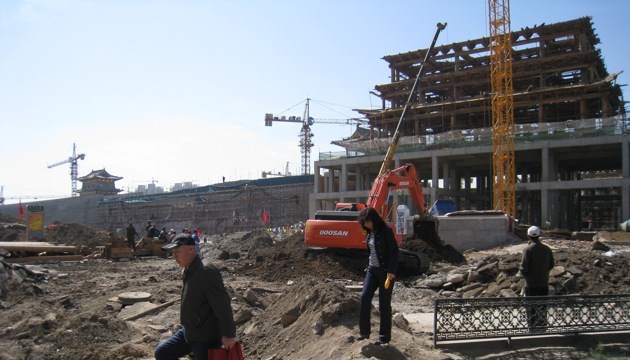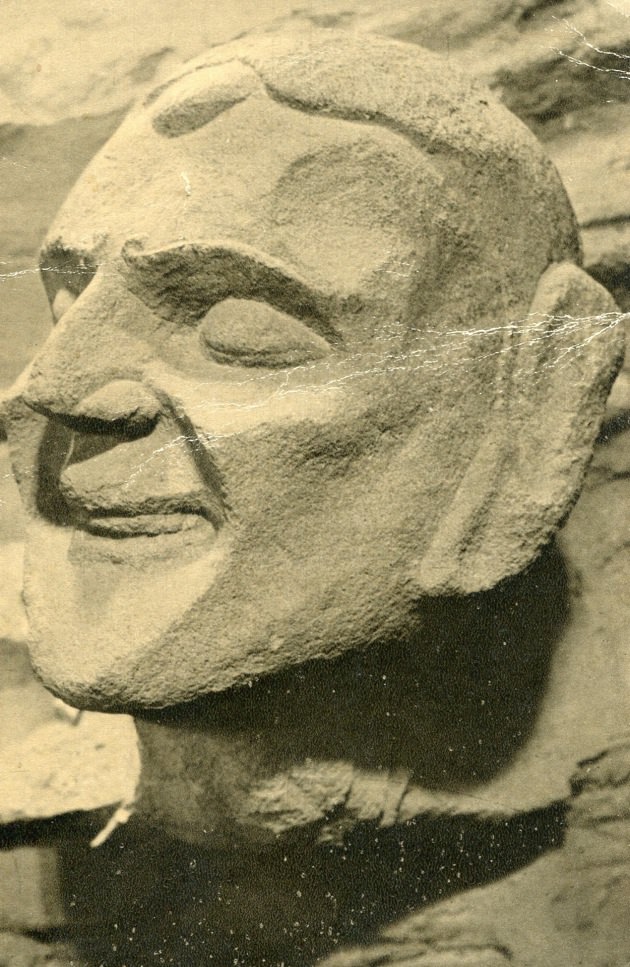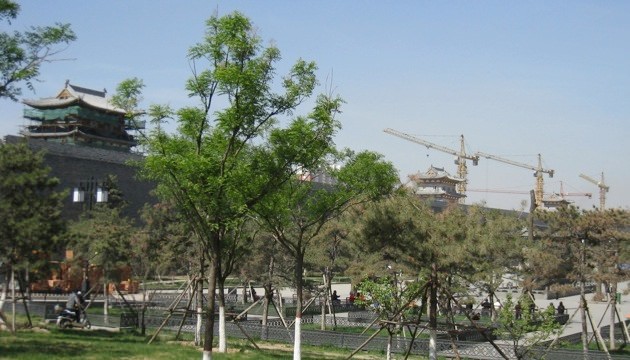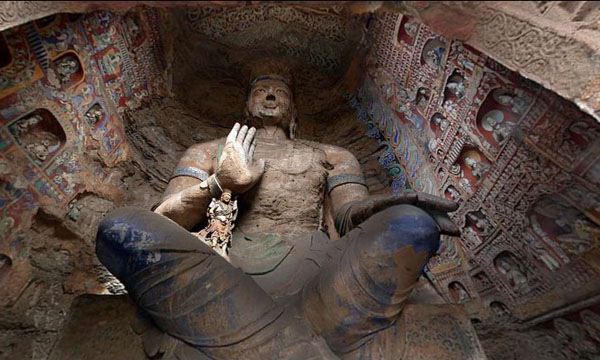I first went to Datong in 1984 and was immediately taken by this gritty city in China’s northern Shanxi Province. Along with half a dozen classmates from Peking University, I traveled eight hours on an overnight train, arriving in a place that felt even more old-fashioned than Beijing was at the time. It was one of those cities that seemed to exist in a world of black and white: the streets and buildings were covered with soot and grime from nearby coal mines, while outside town, farmers toiled on the bleached soil of the Loess Plateau, creviced and exhausted after millennia of human demands.
But Datong was also blessed with cultural treasures that glinted like dusty diamonds. Just outside our dilapidated state-run hotel were the city’s two awe-inspiring Buddhist temples: Huayansi and Shanhuasi. Housing beautiful Buddhist statues and paintings from the twelfth century that had escaped destruction, they were small, perfect buildings set amid the crumbling and chaotic old city, whose massive walls were still partly intact. The Yungang Grottoes, just out of town, were even more remarkable. The caves contain Buddhist sculptures from the fifth and sixth centuries. At the time, the grottoes had a tiny gift shop offering only black and white postcards. One, a bust of an ecstatic disciple of Sakyamuni, sat on my desk for years.
I’ve been in China long enough to know the futility of nostalgia for old cities, but I was still shocked when I recently made a trip back for the first time in ten years. Datong is now booming, thanks to the region’s rich coal reserves, which have created a class of coal barons as wealthy and crass as any character on the TV show “Dallas.” As with most Chinese cities, Datong is in the grips of rampant real estate speculation, with poor people evicted from their homes in the old city, which is being torn down for new developments. (This is a topic I explore in the context of recent books on the destruction of Beijing in new piece for the NYR.) Datong is famous for a noodle known as daoxiaomian—in traditional restaurants, cooks deftly shave strips off a big block of dough, shooting the noodles directly into a pot of boiling water. My favorite restaurant had of course been leveled, and the only option was a faceless fast food chain that went by the invented English name Eastwheat.
What’s surprising is how all this happened. Over the past few decades, Chinese cities have seen their historic centers erased by a generic vision of modernization: broad boulevards and highways, office towers and luxury flats. In Datong, that vision had its day in the 1990s and 2000s. Now, this old-fashioned coal-mining city is on the cutting edge of a new urban development strategy: recreating an imagined, glorious Chinese past. I’d seen this in parts of Beijing, especially around the Qianmen area—an old central neighborhood of shops and restaurants that had flourished through the early twentieth century and was rebuilt in faux-historic style in the run-up to the 2008 Olympics—or at the Xintiandi shopping mall in Shanghai. But Datong is something else. It’s not only a few shopping districts that are being recreated, but vast swaths of an old city that just decades earlier had been obliterated in a fit of auto-cultural genocide: rampant, unregulated development in the name of modernization.
The efforts are centered on rebuilding the once-magnificent city walls. Most stretches had come down in the Mao era and the rest were destroyed to make way for new buildings in the 1990s. Now, they are being rebuilt, mostly from scratch. Already, half of the center of Datong is encircled by the the new walls, which are a full scale replica of the originals: thirty-nine feet high and sixty feet wide at the base. Every few hundred yards are watchtowers and every few watchtowers,a hole punched in the wall for traffic to pass through. There’s little evidence that traditional methods or materials are being used, despite claims to the contrary. Construction cranes line the wall like siege engines, depositing pallets of freshly baked red brick that fill in steel-reinforced concrete pillars. Grey stones cover the skeleton to give it an old look.
It’s hard to pinpoint exactly when this trend began but it seems to be driven by tourism. Over the past decade, well-preserved old cities like Pingyao (240 miles south of Datong) have become major tourist destinations thanks to their city walls and old streets. But there’s also a deeper sense in China of the country having lost too much in the past century of destruction. The revival of Confucian thought, for example, is a way of finding out how Chinese did things in the past—before the country’s experiments with fascism, communism and authoritarian capitalism. City walls and the like are a more concrete manifestation of this desire to turn back the clock.
Advertisement
Datong’s efforts began in 2009 and officials say they will invest more than one billion yuan, or about one hundred and fifty million dollars, over four years. Like most projects, the money is borrowed from local banks, which are partly controlled by local political leaders. The money is to be repaid by selling land—which the city controls—to real estate developers.
The walls are only part of the plan. The city has also completely changed the look of the temples and grottoes. They have ballooned grotesquely in size—forcing visitors to walk through endless new structures before getting to the original site. Huayansi, for example, was made roughly ten times bigger than it was in 2008 with the addition of a huge series of faux-Tang style buildings filled with new Buddhist statues—none of which are controlled by the Buddhist monks who run the original temple. Likewise the Yungang Grottoes have new gardens, temples, shopping streets and a visitor center tacked onto them. (The original statues, thank goodness, have been left alone and are as inspiring as ever.)
To be fair, the effect is not entirely displeasing—there are trees and fake lakes to soften the harsh landscape—but the area has been entirely transformed. Once the grottoes were lonely, poignant relics at the base of a small cliff—survivors of all the radical changes in China over the last fifteen hundred years, and a tribute to Buddhism’s endurng appeal. Now they are centerpieces of an ambitious economic development plan. In his classic book on Buddhist pilgrimage sites, the translator and travel writer Bill Porter caught an early glimpse of the changes hitting Datong and entitled his chapter on the city “No Buddha.”
The new construction is designed to justify outrageous ticket prices. In 2008, the Yungang Grottoes cost 40 yuan ($6.50), a not unsubstantial fee in a developing country but still manageable. Entry now costs 150—more than $25. The famous Hanging Temple (xuankongsi) outside town now costs 130 yuan, while the two temples in town are 80 yuan and 50 yuan. That’s $65 to see four religious sites, or just a little less than the average rural resident earns in a month. By contrast, Beijing’s eight-million-square-foot Forbidden City costs just 60 yuan to enter. Datong’s sites are not empty—China has enough wealthy people to keep them well-visited—but they are out of reach of ordinary people.
The projects have focused attention on Datong’s high-profile mayor, Geng Yanbo, who has polarized the city over his plans. Some are excited that the city is recapturing some of its old flair and glad that it won’t have to rely forever on coal. But the construction projects have displaced thousands. According to government figures, more than 116 acres of the city were razed in 2009 alone. Protests are now regular occurrences throughout Datong and Mayor Geng has been dubbed the “devil mayor” on local blogs.
The mayor’s hyper-activism is a response to the demand from on high to show results. Mayor Geng was appointed to his current position in 2008. He has roughly until the end of next year until his term is up and he is rotated out, which means the officials in the Communist Party’s Organization Department are already trying to figure out how his tenure should be evaluated. If he is seen as having expanded a key industry—tourism—and helped revive pride in traditional China, another central government goal, he will have been judged successful. The protests probably won’t count against him because they are ubiquitous in urban China. The same calculation is being made now in cities across the country. In the Yangtze port metropolis of Chongqing, for example, Party Secretary Bo Xilai has tarted up his city with a costly [tree-planting campaign] (http://www.theatlantic.com/international/archive/2011/05/gingko-fever-in-chongqing-the-billion-dollar-trees-of-central-china/238885/) and appeals to China’s revolutionary past.
I must admit to mixed feelings about all this. Primping up ancient temples and then fleecing visitors to pay for them is cultural barbarism. So too the movie lot-quality buildings that now surround the Yungang Grottoes. (Note to the United Nations Educational, Scientific and Cultural Organization, which conferred World Heritage status on the grottoes in 2001: why does Dresden’s Elbe Valley lose World Heritage Site status for building a bridge over the Elbe but China gets away with outrages like Yungang?)
Yet I also feel a secret thrill. Part of it is practical: Datong is a lot greener than it was before, and the city’s new walls are impressive—how often do you see a modern city enclosed in medieval-style walls?—no matter how much concrete was used to build them. But it goes further than that. China has gone through incredible turmoil over the past century and a half. Now, thanks to three decades of growth and relative stability, Chinese people are asking themselves again what it mean to be Chinese—how, for example, they want their cities to look.
Advertisement
China’s current political system does not allow these questions to be answered with enough public debate and input; it is still too authoritarian and cities like Datong are too much the pawns of petty bosses like Mayor Geng. And some of this is part of an obvious government effort to foster a sense of pride in China’s past. Yet something genuinely exciting is afoot in China. People are interested in the past and, flawed as these efforts now are, they are trying to recapture something of the old glory of being Chinese. Datong’s city walls and its sprawling new old city are part of this. In time, they may be seen as authentically representative of their era as the grit and grime that once characterized this rough North China city.






